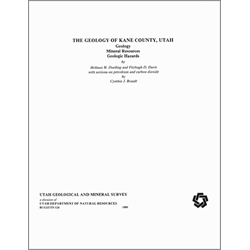The geology of Kane County, Utah: geology, mineral resources, and geologic hazards (B-124)
By: H. H. Doelling, F. D. Davis, and C. J. Brandt
Kane County, with its 4105 square miles, lies along the south-central margin of Utah and is found in the western part of the Colorado Plateaus physiographic province. It is famous for scenic beauty displayed in its colorful rock formations and other geologic features such as faults, folds, arches, monoclines, joints, cross beds, cliffs, lava fields, and canyons. Kane County contains parts of Bryce and Zion National Parks, the Glen Canyon Recreation Area, and it is home to the Coral Pink Sand Dunes and Kodachrome Basin State Parks. The county area has had an interesting geologic history and important fossil finds have added much to our knowledge of world geology. The total value of the mineral production of Kane County, Utah through 1985 is estimated at $21,854,000, of which more than 95 percent is attributed to construction materials, mined or quarried to build and maintain highways. Sand and gravel, crushed stone, coal, gemstones, pumice and volcanic ash, manganese ore, gold, uranium, silver, copper and lead were or have been produced, with the most important current commodities being construction and gem materials. The annual rate of production of these items is erratic, but the value averages a few hundred thousand dollars annually. The production of the construction materials is dependent on the schedules of the Utah Department of Transportation and other road building agencies. Gem materials are mined intermittently to supply the tourist trade. Currently, there are no large, regularly producing mining operations in the county. Other mineral deposits reported in Kane County include titanium and zirconium, gypsum and anhydrite, limestone and dolomite, clay, and vanadium. About 29 tests for petroleum have thus far been drilled without significant success. However, many had interesting shows of oil and gas and the potential for discovery remains high.
Kane County increased its population by more than 66 percent between 1970 and 1980 and this trend continues. Because the area is sparsely settled, however, public awareness of geologic hazards of Kane County is probably not widespread. Kane County has experienced earthquakes and there are active, even chronic landslide problems. Serious problems include flash floods, which require extensive road maintenance, as they cut away sections of road, weaken bridge abutments and generally make travel impossible. Homebuilders should be aware of compactible soils and rock fall areas.
Other Information:
Published: 1989
Pages: 192 p.
Plates: 10 pl.
Scale:1:000,000, 1:36,000, 1:30,000 & 1:24,000
Location: Kane County
Media Type: Report and Map Publication







